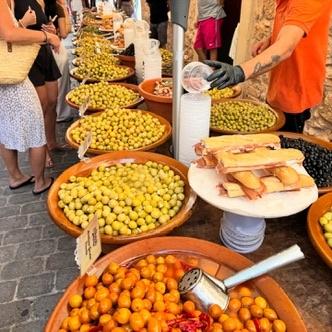What distinguishes the Arbequina and Mallorquina olive varieties grown in Mallorca?
Similar Topics
arbequina olives
mallorquina olives
mallorca olive varieties
olive oil flavor
high oil content
mediterranean olives
olive oil tasting
mallorcan cuisine
The Arbequina and Mallorquina olive varieties, both native to Mallorca, are distinguished by their unique characteristics that reflect the island's diverse agricultural heritage and climatic conditions. Arbequina olives are smaller, with a smooth, round shape and a light to medium-dark brownish-purple hue when ripe. They are renowned for their high oil content and delicate, fruity flavor profile, which produces a sweet, buttery olive oil notes that are highly prized in both local and international markets. This variety's adaptability has made it popular beyond Mallorca, thriving in various Mediterranean climates.
In contrast, the Mallorquina olive, less widespread than the Arbequina, is typically larger and more elongated, with a darker, almost black skin at full ripeness. The oil yield from Mallorquina olives is slightly lower, but the oil itself is characterized by a more robust, slightly bitter and pungent flavor that offers a distinctive sharpness and earthiness. This profile is reflective of the traditional Mallorcan palate and the island’s terraced landscapes where these trees are often grown. The Mallorquina olive trees are hardier and can adapt well to the island’s varied microclimates, maintaining a balance of flavor that complements Mallorca’s cuisine.
Both varieties contribute significantly to the cultural and gastronomic identity of Mallorca. While Arbequina is favoured for its versatility and smooth taste, making it suitable for salads and delicate dishes, Mallorquina presents a more intense olive oil option valued for cooking and seasoning robust foods. Together, these olives showcase the island’s rich agricultural tradition, illustrating how local growers harness their environment to produce oils that capture Mallorca’s essence. Visitors to the island can appreciate this diversity through tastings and tours, where the contrasts between the Arbequina’s mellow elegance and the Mallorquina’s bold character are especially apparent.
In contrast, the Mallorquina olive, less widespread than the Arbequina, is typically larger and more elongated, with a darker, almost black skin at full ripeness. The oil yield from Mallorquina olives is slightly lower, but the oil itself is characterized by a more robust, slightly bitter and pungent flavor that offers a distinctive sharpness and earthiness. This profile is reflective of the traditional Mallorcan palate and the island’s terraced landscapes where these trees are often grown. The Mallorquina olive trees are hardier and can adapt well to the island’s varied microclimates, maintaining a balance of flavor that complements Mallorca’s cuisine.
Both varieties contribute significantly to the cultural and gastronomic identity of Mallorca. While Arbequina is favoured for its versatility and smooth taste, making it suitable for salads and delicate dishes, Mallorquina presents a more intense olive oil option valued for cooking and seasoning robust foods. Together, these olives showcase the island’s rich agricultural tradition, illustrating how local growers harness their environment to produce oils that capture Mallorca’s essence. Visitors to the island can appreciate this diversity through tastings and tours, where the contrasts between the Arbequina’s mellow elegance and the Mallorquina’s bold character are especially apparent.
🧩 Related Questions
Related Question
Is the small-fruited asphodel available in markets or restaurants across Mallorca today?
Related Question
How can visitors experience authentic Mallorcan all-i-oli beyond just the main restaurants?
Related Question
How convenient is it to transfer between the Sóller train and Palma’s broader commuter rail network?
